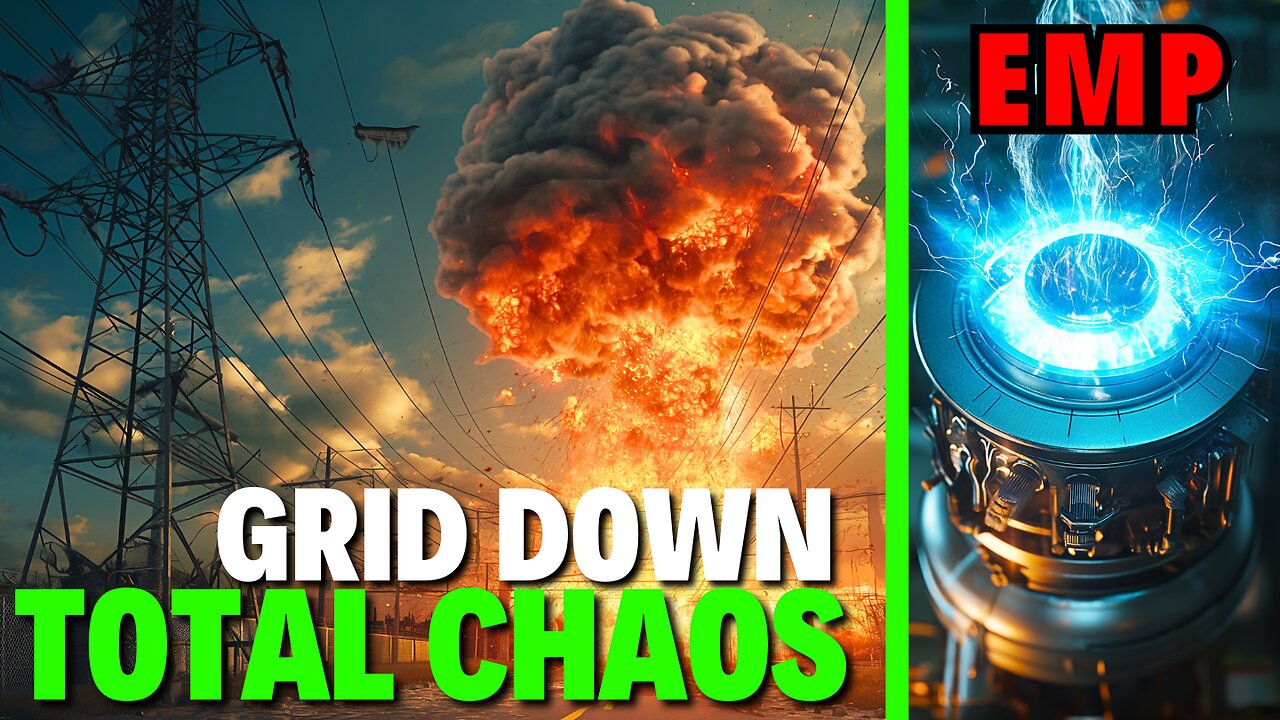Premium Only Content

The Coming U.S. Power Grid Collapse: What You Should Know
The Coming U.S. Power Grid Collapse: What You Should Know
In an era defined by advanced technology and high dependence on electrical power, the robustness of the U.S. power grid is more critical than ever. However, experts warn of a looming threat that could plunge the nation into darkness: a potential collapse of the U.S. power grid. This article explores the causes, potential impacts, and crucial measures that individuals and authorities can take to mitigate this looming crisis.
Understanding the U.S. Power Grid
The U.S. power grid is a complex network that delivers electricity from producers to consumers. It comprises three major components: power generation, transmission, and distribution. This grid is not just a single entity but a vast, interconnected system of smaller grids, making it one of the world's largest and most intricate machines.
Aging Infrastructure: Much of the grid's infrastructure is decades old and not designed for the current demand levels or the integration of renewable energy sources. Aging equipment is more prone to failures, which can cascade into widespread outages.
Cyber Attacks: As our grid becomes increasingly digital, it becomes more vulnerable to cyber-attacks. A well-coordinated attack could disrupt critical infrastructure and cause extensive blackouts.
Extreme weather events like hurricanes, floods, and wildfires, exacerbated by climate change, pose a significant threat to the power grid. These events can damage key components, leading to prolonged outages.
Physical Attacks: Attacks on substations and other physical components of the grid could lead to significant disruptions. Such attacks could be part of terrorism or sabotage efforts.
Overloading and Lack of Upgrades: The increasing demand for electricity, especially during peak times, strains the grid. Without significant upgrades and maintenance, this strain could lead to a collapse.
Impacts of a Grid Collapse
A widespread power grid failure would have catastrophic consequences:
Loss of Critical Services: Hospitals, emergency services, water treatment facilities, and communication networks rely heavily on electricity. Their failure could have dire implications for public health and safety.
A prolonged blackout could lead to significant economic losses. Industries would halt, businesses would close, and the financial markets could be severely impacted.
Extended periods without power could lead to social unrest. The lack of basic amenities like heating, cooling, and lighting could create challenging living conditions, leading to public frustration and potential unrest.
Food and Water Shortages: Refrigeration is vital for food storage. A power grid failure could lead to widespread spoilage of perishables, leading to food shortages. Water supply systems also depend on electricity, risking water shortages.
Upgrading the grid with advanced technologies like smart grid systems can enhance resilience. These systems can quickly identify and isolate problems, preventing cascading failures.
Incorporating more renewable energy sources can reduce the strain on the grid and provide more distributed power generation, enhancing stability.
Strengthening cybersecurity protocols and infrastructure is critical to protecting the grid from cyber-attacks.
Educating the public about potential blackouts and encouraging preparedness can mitigate the impact. This includes having emergency kits, backup power sources, and contingency plans.
Significant investment in upgrading and maintaining the grid infrastructure is essential. This includes replacing aging components and enhancing capacity to handle increasing demand and renewable integrations.
The potential collapse of the U.S. power grid is a stark reminder of our dependence on electricity and the fragility of the systems that provide it. Proactive measures, both at the individual and systemic levels, are essential to prevent a catastrophic failure. The challenge is immense, but with coordinated effort & investment, a more resilient and secure power grid is achievable.
In conclusion, while the threat of a power grid collapse is real, understanding the causes, impacts, and mitigation strategies is crucial. It calls for a collective effort from government, industry, and individuals to safeguard this critical infrastructure. Preparing for the worst while working towards a resilient and modern grid is not just a choice but a necessity in our ever-evolving and electrified world.
00:00 - Introduction
00:35 - The Importance of Electricity
01:12 - Consequences for Society
02:26 - The US Power Grid Explained
03:39 - Immediate Effects of Grid Failure
05:14 - Economic Impacts
06:00 - Healthcare Challenges
07:22 - Effects on the Elderly
07:59 - Financial Systems Shutdown
09:07 - Employment Challenges
10:05 - Food and Water Security
13:22- Closing
'Vengeance' by Scott Buckley - released under CC-BY 4.0. www.scottbuckley.com.au
#powergridcollaspe #uspowergridcollaspe #powergridattack
-
 LIVE
LIVE
AP4Liberty
1 hour agoRocket Man Trump Declares Peace in the Middle East: Will Iran or Israel listen?
242 watching -
 8:44
8:44
Warren Smith - Secret Scholar Society
13 hours agoHitman's Confession PROVES Iran's Plot to Assassinate Trump
143K105 -
 7:45
7:45
Sugar Spun Run
1 day ago $2.11 earnedBBQ Chicken Meatballs
10K2 -
 2:00:18
2:00:18
BEK TV
1 day agoTrent Loos in the Morning 6/24/2025
9.76K -
 LIVE
LIVE
The Bubba Army
23 hours ago12 Day War OVER?! - Bubba the Love Sponge® Show | 6/24/25
1,555 watching -
 25:59
25:59
Degenerate Jay
1 day ago $1.29 earnedThe Biggest Problem With Modern Video Games
34.9K2 -
 3:19
3:19
The Official Steve Harvey
17 hours ago $1.32 earnedBefore You Pitch It… PROTECT IT. Steve Harvey’s Real Talk
19.8K1 -
![🟢 LIVE - Star Citizen [ MFD Key Bindings and Stream Deck XL ]](https://1a-1791.com/video/fww1/96/s8/1/v/e/i/W/veiWy.0kob.1-small--LIVE-Star-Citizen-MFD-Key-.jpg) 7:18:52
7:18:52
Delnorin Games
7 hours ago🟢 LIVE - Star Citizen [ MFD Key Bindings and Stream Deck XL ]
18.1K -
 3:30
3:30
Rena Malik, M.D.
1 day ago $1.19 earnedUrologist Reacts to Dr. Glaucomflecken's First Day of Urology
19.6K4 -
 1:30:36
1:30:36
TheBeardedBrent
3 hours ago🔴LIVE🔥 | FORTNITE | #1 BLITZ BOT!! | ROAD TO 100 SUBS!!🔥
21.5K2